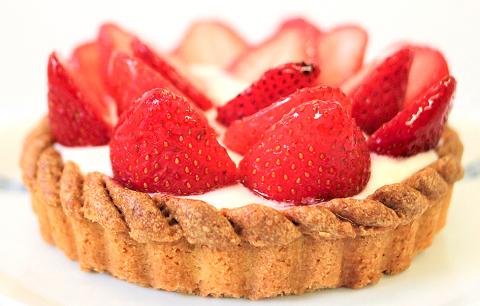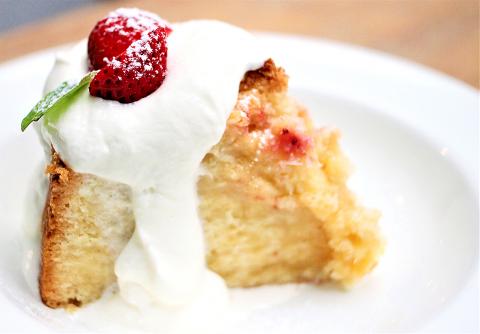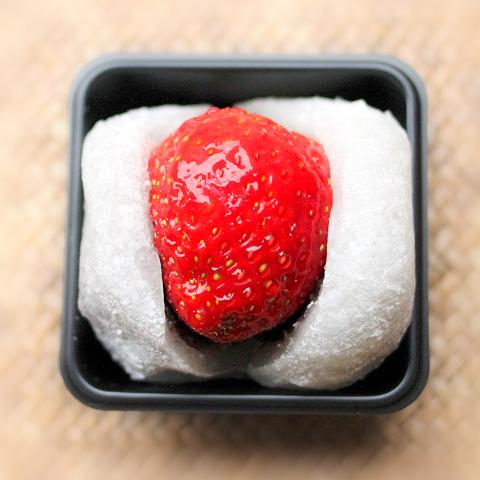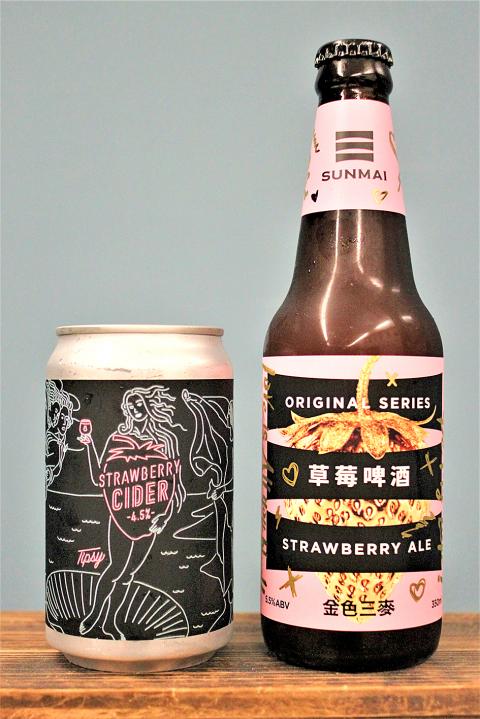The locally-grown strawberry, now in the last weeks of its peak season from December to March, is beyond comparison with the flavorless imported variety available year-round in supermarkets. Even at a distance, just walking past a roadside strawberry stall, the fruit’s sweet and sunny musk is intense enough to reach pedestrians. Get closer, and the dewy red exterior promises a juicy, almost syrupy fruit with a spirited tang.
Dahu (大湖) township in Miaoli County is the major production hub for strawberries, and has embraced its identity as the “Strawberry Kingdom,” but strawberries are now also grown throughout Taiwan. Despite the popularity and quality of the fruit here, the strawberry is not indigeneous. According to the Council of Agriculture in the Executive Yuan, the strawberry was introduced during the Japanese colonial period, and records of its cultivation in Taiwan date back to 1934.
The unadorned fruit is spectacular by itself. But Taiwan’s strawberry season also inspires an annual profusion of limited-time strawberry-centered offerings, featuring uses of the fruit that enhance its natural qualities. Before the season ends this month, these treats are worth an expedition.

Photo: Davina Tham, Taipei Times
STRAWBERRY DAIFUKU
Lin’s Wagashi (滋養製菓) specializes in traditional Japanese confectionery with a Taiwanese touch. Dainty morsels like brown sugar mochi, baked mantou (饅頭) with chestnut, chocolate or bean fillings and pineapple tarts fill the shelves. The winter-exclusive strawberry daifuku (NT$65 for one) places a single, glistening strawberry on a pat of red bean paste in between a mochi, or glutinous rice cake. The sharp burst of berry complements the sweet beans and mellow mochi, which is as soft and smooth as a baby’s bottom. The daifuku are also available in gift boxes of eight (NT$520) or 12 (NT$780).
■ Lin’s Wagashi (滋養製菓), 247, Dihua St Sec 1, Taipei City (台北市迪化街一段247號); open daily, 9am to 7pm

Photo: Davina Tham, Taipei Times
STRAWBERRY TART
Customers of Tom’s Bakery (棠舖) have asked the shop to make its signature strawberry tart available year-round by using imported strawberries, but to no avail. The exacting baker-owner insists on using only seasonal local strawberries, spurning the imported variety because it “tastes bad.” The four-inch tart (NT$450) combines three components done to perfection — a crisp, buttery tart crust filled with tangy lemon mascarpone, topped with succulent strawberry slices. The flavors are intense, so one four-inch tart is enough to satisfy three or four people.
■ Tom’s Bakery (棠舖), 4, Lane 51, Tianshui Rd, Taipei City (台北市天水路51巷4號); open Tuesday to Sunday, 10am to 7pm

Photo: Davina Tham, Taipei Times
STRAWBERRY CAKES
Reservations are a must at Flugel Studio, a favorite of young city-dwellers looking for rich Western-style cakes and tarts. Here, strawberries are deployed in multiple distinctive ways. Given the current cold snap, a slice of dense coconut and strawberry cake (NT$180), served warm and topped with refillable whipped cream, is an attractive option. The bakery’s take on tiramisu sees Italian ladyfingers soaked in an orange syrup and filled with a kirsch custard and ripe strawberries (NT$200). There are also at least two versions of strawberry cheesecake, including a traditional baked cheesecake and a Japanese-style vanilla and lemon-inflected “rare,” unbaked cheesecake (both NT$180).
■ Flugel Studio, 3, Lane 34, Xinhai Rd Sec 1, Taipei City (台北市辛亥路一段34巷3號); open Wednesday to Friday, 2pm to 7pm, and Saturday and Sunday, 1pm to 7pm

Photo: Davina Tham, Taipei Times
Warning: Excessive consumption of alcohol can damage your health.
STRAWBERRY ALCOHOL
While not limited to the strawberry season, local brewing companies are taking advantage of Taiwan’s exceptional strawberry crop by incorporating it into their brews. Taihu Brewing’s (臺虎精釀) Tipsy range offers a strawberry cider (NT$69) that’s worth getting for the can alone, with its cheeky depiction of Venus emerging from her clam shell in neon lights. The drink itself is everything to be hoped for, with a stunning rose gold color, sweet and fizzy start and tart finish to keep things refreshing. Sunmai’s (金色三麥) strawberry ale (NT$125) is its slightly more serious cousin.
■ Available at leading supermarkets
PICKING STRAWBERRIES
In the 1990s, leisure farms in Miaoli began offering the strawberry-picking experience in a rustic setting. Taipei’s strawberry leisure farms are located in the northern reaches of Neihu District (內湖), clustered on Dahu Street (大湖街) stretching to Antai Street (安泰街) and in the Baishihu (白石湖) area along Bishan Road (碧山路). While large-scale strawberry production is winding down in the rest of the country, strawberry-picking fervor in the north is just now reaching its peak, with the official opening of the Neihu strawberry season today. Aside from the strawberry harvest, some farms also offer jam-making and pizza-making classes and a chance to pick other seasonal produce.
■ Kuei Hsiang Strawberry Garden (桂香草莓園), 206, Dahu St, Taipei City (台北市大湖街206號); open Saturday and Sunday, 9:30am to 7:30pm; on the Web: www.facebook.com/HC1027. No admission required, but a kilogram costs NT$300
■ Farmily (美麗田農園), 38-1, Bishan Rd, Taipei City (台北市碧山路58-1號); open Saturday and Sunday, 11am to 7pm; on the Web: www.facebook.com/StrawberryFarmer

The canonical shot of an East Asian city is a night skyline studded with towering apartment and office buildings, bright with neon and plastic signage, a landscape of energy and modernity. Another classic image is the same city seen from above, in which identical apartment towers march across the city, spilling out over nearby geography, like stylized soldiers colonizing new territory in a board game. Densely populated dynamic conurbations of money, technological innovation and convenience, it is hard to see the cities of East Asia as what they truly are: necropolises. Why is this? The East Asian development model, with

June 16 to June 22 The following flyer appeared on the streets of Hsinchu on June 12, 1895: “Taipei has already fallen to the Japanese barbarians, who have brought great misery to our land and people. We heard that the Japanese occupiers will tax our gardens, our houses, our bodies, and even our chickens, dogs, cows and pigs. They wear their hair wild, carve their teeth, tattoo their foreheads, wear strange clothes and speak a strange language. How can we be ruled by such people?” Posted by civilian militia leader Wu Tang-hsing (吳湯興), it was a call to arms to retake

This is a deeply unsettling period in Taiwan. Uncertainties are everywhere while everyone waits for a small army of other shoes to drop on nearly every front. During challenging times, interesting political changes can happen, yet all three major political parties are beset with scandals, strife and self-inflicted wounds. As the ruling party, the Democratic Progressive Party (DPP) is held accountable for not only the challenges to the party, but also the nation. Taiwan is geopolitically and economically under threat. Domestically, the administration is under siege by the opposition-controlled legislature and growing discontent with what opponents characterize as arrogant, autocratic

When Lisa, 20, laces into her ultra-high heels for her shift at a strip club in Ukraine’s Kharkiv, she knows that aside from dancing, she will have to comfort traumatized soldiers. Since Russia’s 2022 invasion, exhausted troops are the main clientele of the Flash Dancers club in the center of the northeastern city, just 20 kilometers from Russian forces. For some customers, it provides an “escape” from the war, said Valerya Zavatska — a 25-year-old law graduate who runs the club with her mother, an ex-dancer. But many are not there just for the show. They “want to talk about what hurts,” she